So, I am now a few weeks into training. They keep us really busy, and quality internet is even harder to come by than I’d imagined. There’s a lot to tell; here’s a preview of what’s in this mega email so you can jump ahead to the parts you care about (click on them):
- Arrival in Guatemala
- Temporary host family in Santa Lucia Milpas Altas
- Food
- Items of architectural/ construction significance
- Internet, phones, and communication
- Cockroaches, intestinal parasites, and various subtropical maladies
- Chicken Busses and terrifying transportation
- Machetes and Riding Shotgun
Before I jump into details, I want to say that I’m having a very busy, very alien, very REAL experience here. There is a lot to be done to integrate into a completely foreign culture, and then carry out the mission. Speaking of which, what is this all about? The Peace Corps has three main goals:
- To help improve the living conditions for neglected peoples in underdeveloped nations.
- To extend the goodwill of the American people to other countries in need, demonstrating the generosity and humanity that is a fundamental American trait.
- To bring knowledge of other cultures back to Americans at home, thereby enriching their lives and increasing their awareness of other people and cultures around the world.
Those of you that helped to make this trip possible for Emily and I, either by monetary or emotional support, have already done a lot to further the second goal. And those of you that are reading this letter home right now are helping me to further the third goal.
Right. So, lets get down to it.
Arrival in Guatemala
After being woken at 4:30 am to wait in the airport for 5 hours (yay government), we caught our 4-hour flight to Guatemala City. This is the only international airport in Guatemala, and is actually closer to Washington DC than is, say, Salt Lake City Utah. Guatemala City (the Capitol, as they call it) is rife with crime, so we were whisked away before we saw much of it. Friendly Peace Corps Guatemala staff loaded us in a bus, passed out some juice drinks, and an hour later we were in the training town of Santa Lucia Milpas Altas. Here’s a picture of a scenic shantytown on the outskirts of Guatemala City:
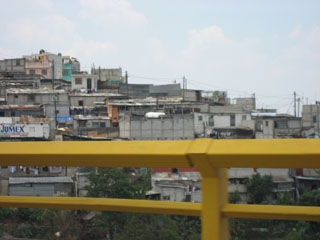
Temporary host family in Santa Lucia Milpas Altas
The training center and headquarters for Peace Corps Guatemala is in Santa Lucia, a pleasant little town in the mountains between the Capitol and Antigua, the former capitol from the 1500s. It’s situated at about 7,000′ above sea level, so I was breathing pretty hard after any kind of exertion. We were taken in groups of three or four to meet the families that had offered to host us for the first three days until we could be assigned to our real host families for the rest of the 3-month training. I was pleasantly surprised to find that Emily and i would be in the same place for now… double nice because the family we got had no English whatsoever, and i was too tired to speak Spanish to them so Emily handled it.
The family of 4 was very friendly… and very poor. They had all moved into one bedroom so they could accommodate the four of us in two other rooms, thus gaining a little extra income for three days. (If you scroll down a few sections, you can see some pictures of how their house looked.) Their shower was a single 1/2” cold water pipe sticking out of the wall, and their doors were old bedsheets nailed over openings in the walls. Their roof is corrugated tin sheets. Their kids were pretty friendly and asked a lot of questions about us and our families. Here is a picture of their neighbor’s house (I was worried I’d offend them if I took a picture of theirs):
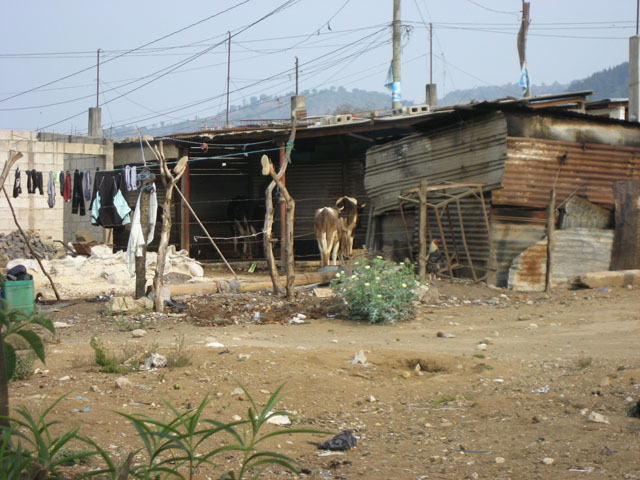
On our last night there, they found out it was my birthday, and we had a little party. They bought a two-liter of coke to celebrate, and Favi (one of the other volunteers staying in the house) brought out her laptop so we could listen to some music. The older of the two kids started playing with Powerpoint after a bit, making some kid-art using his name and some clip art. I was pretty impressed the kid was so computer savvy; apparently he learned that in school. It’s depressing to think that Favi’s laptop probably cost more than their house. And that kid was having such a good time. It really bothered me that at my office (and those of several of my friends) we have old laptops that aren’t really useful anymore to us, but would be so appreciated in a place like this, and they get tossed into the dumpster or collect dust in a storage room.
The Peace Corps training & admin center itself is a bit more elaborate, and has some security features. Besides the visible cameras, gates, razor wire, etc. it also has armed guards (Guatemalan) and a security director (American).
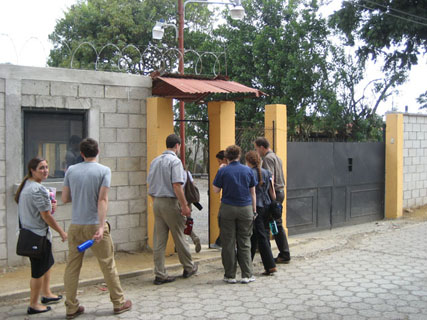
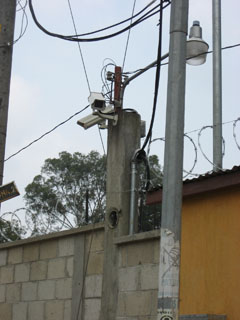
Food
The food here is pretty palatable so far. The main staples here are corn tortillas and beans, two things I like. But when they say “staples”, they mean that it makes up about three-quarters of their diet. I am starting to get tired of beans… stewed bean, baked beans, refried beans, creamed beans, you name it. Also, we have been strongly advised to stay away from anything sold in the street or markets, to avoid SERIOUS gastrointestinal hardship (see section on intestinal parasites farther down). My host mom fixes pretty yummy stuff, and seems to follow most of the food safety guidelines most of the time. They do serve the occasional odd dish here, though, such as:
- Stewed bananas. Yep, not joking, and they’re kinda creepy.
- Cornflakes appear occasionally at breakfast time. This would not be so weird, except that the milk they go into is always steaming hot.
Items of architectural/ construction significance
There’s a lot of weird stuff going on here in the built environment. Back in 1976, they had a really bad earthquake that killed a bunch of people. At that time, most single family dwellings were loadbearing adobe with clay tile roofs- a pretty slick mechanism for crushing those sleeping within during an earthquake (it happened at 4am). Nowadays, nearly all construction is concrete block walls with an 8×8 reinforced concrete pilaster coplanar with the wall every 8 feet or so on center. It appears to be an empirically designed thing, and i see it everywhere. Roofs are corrugated tin sheets.
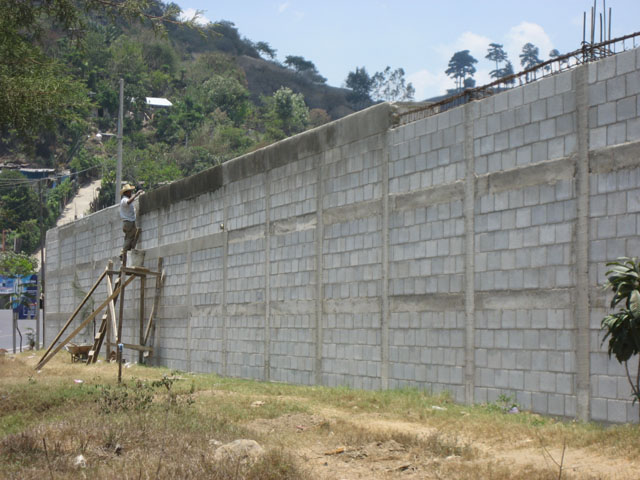
Across the street from my house, a set of concrete bleachers is under construction. Again, reinforced concrete and masonry, then a skim coat of concrete plaster over the whole mess. The cool part is that they do all this work entirely by brute manpower: no transit mixers, no skid loaders, nothing. Just buckets, wheelbarrows, and a few forms. And lots of guys standing around earning about $25 a week (I asked).
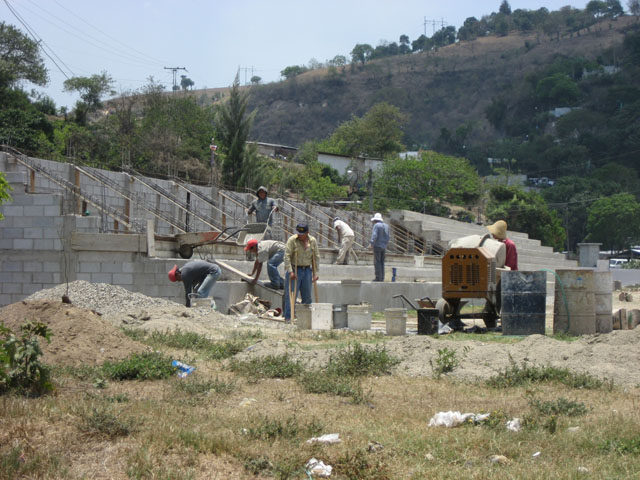
I don’t think they have electricians here, and that’s OK, because they don’t use much electricity… nearest I can tell is that each house here uses about 30 amps max, if you turn everything at once in the entire building. As a result, the wiring is kindof suspicious. This first picture is “conduit”, the second is typical wiring for lights and the occasional outlet, the third is a in-house soundsystem:
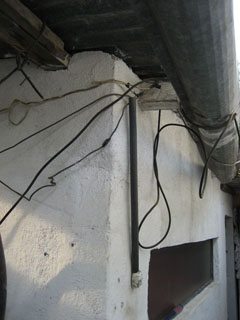

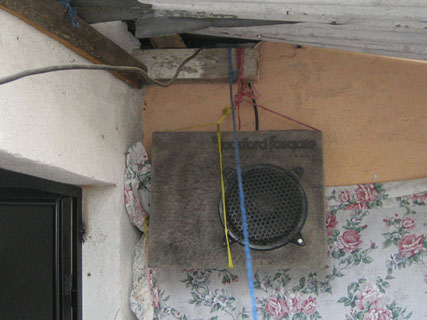
This next picture is how we get hot showers, for those of us that live in the posh places that have it. Cold water comes out of the wall, with a tap to control flow. That giant showerhead has an electrical heating element in it that click on when it senses water flow, heating the water. If you want the water hotter, you turn down the pressure, letting the water spend more time over the element before it comes out. For cooler water, you turn up the water pressure and the opposite happens. When i first saw this electrical device plugged into the bathroom faucet, every alarm in my being went off. And they for SURE don’t know what a GFI outlet is here. But after several days, i needed a hot shower so badly i no longer cared.
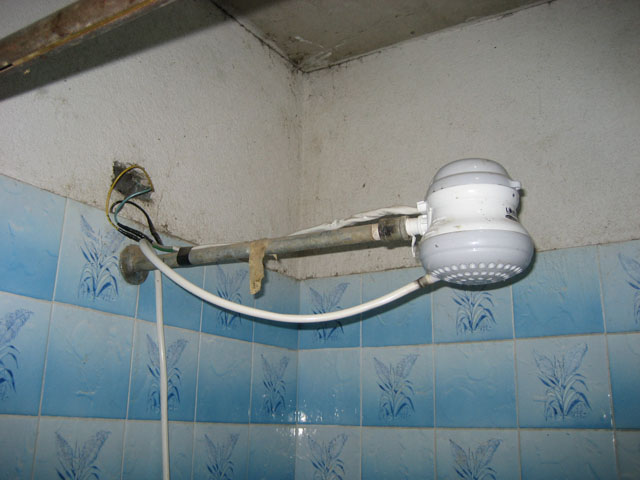
And I am always obliged to get a good toilet picture for my friend Jerry. I haven’t seen anything here as terrifying as the toilets I saw in Morocco, but here’s a good runner-up (no pun intended), as well as a hi-tech valve for a urinal:
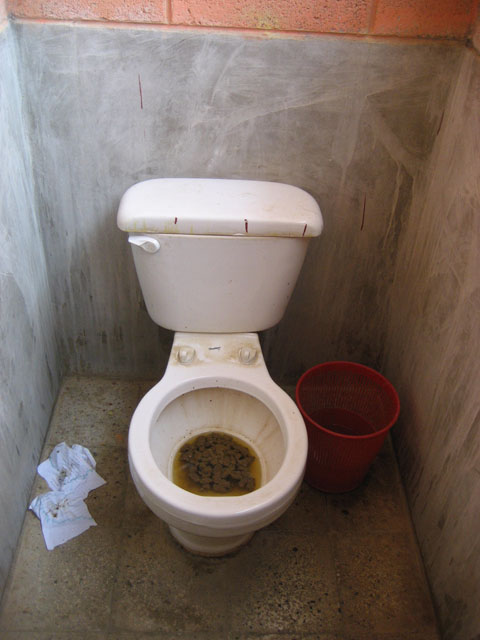

Also, please note that the plumbing here cannot handle paper products at all, so all used toilet paper goes into that little trash can next to the toilet. Simply lovely. Yesterday, my team and I were visiting a regional health center, and the head doctor offered us the key to the executive washroom the doctors use, as a sort of goodwill gesture. Here’s the upgraded version for the medical professionals:
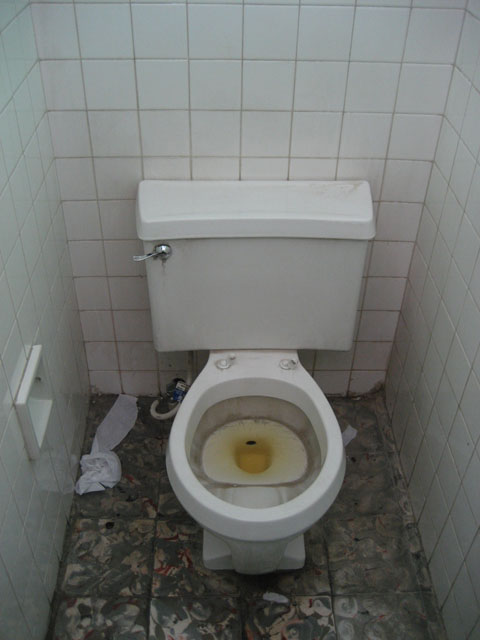
Paper and toilet seat are perks reserved for the hospital administrator, i suppose?
Internet, phones, and communication
The internet has been an issue here. Most towns have internet cafes where you sit and type on the web interface of a public console. The problem lies in that it’s difficult to do anything TRICKY, like manage your website, or use IMAP/POP email, or what have you. In Antigua (the big tourist town) there are two places that offer free WiFi, but that has a problem too… taking a laptop anywhere in Guatemala is taking a risk that you might get robbed of it, but in Antigua, the thieves watch the WiFi sites and have been known to follow laptop owners back to wherever they are going, THEN rob them. My workaround right now is that I get my email & internet with the WiFi on my iPod; i can hold it inconspicuously enough that no one sees it, and it doesn’t bulk up my bag so it looks like I have a laptop.
The cell phone system here is pretty good, has good coverage in the outback, and is relatively cheap. Everyone in the training group has one by now, and we use them to coordinate meetings etc. They are all pay-as-you-go, with a really screwey system… you buy minutes, and depending on how many you bought, they run out after a certain time whether or not you use them. Then, your phone can’t call out again until you buy more minutes, at which point, the amount you just bought gets added to those you hadn’t used.
Confusing? Kinda. Inconvenient? Definitely!
Cockroaches, intestinal parasites, and various subtropical maladies
This is the part that I know everyone’s been waiting for. (Ryan, make sure Dr. Julie sees this.) First off, i want to say that the medical detachment at Peace Corp Guatemala is pretty well prepared, and we’ve had a LOT of thorough seminars so far in training. Right off they bat, they started us on our vaccination sequences. Here’s the list of what I got:
- Hepatitis A vaccine
- Hepatitis B vaccine
- Rabies pre-exposure sequence
- Typhoid vaccine
- Influenza vaccine
- Oral Malaria/yellow fever prophylaxis (this one is cool; i got Doxycycline because of my psoriasis. Although I have to take it every day instead of once a week like the others, it’s nice because I don’t get the delusional-dream side effect. Oh, and mine also works against Anthrax.)
- I already had MMR, tetanus, and the others, so i didn’t need them (yay!)
So, you’d think that I was pretty well protected biologically, right? Not so fast. Guatemala has some pretty creepy stuff, the rest of which has to be prevented the old fashioned way: handwashing, food sanitizing, and a bit of luck. We’ve spent hours talking about the cause and effects of giardia & cryptosporidia (both of those can be found in the USA occasionally), amoebic and bacterial dysentery, hookworm (you get those through your feet! Yay!), roundworm (more than 50% mankind is currently sporting them, and about 5% of volunteers pick them up), tapeworm, pinworm, dengue… the list goes on. They even have a cool local disease called Chagas. How it works is, first you sleep in a house. Preferably adobe. Then, this big bug that’s half cockroach, half mosquito comes out while you are sleeping and crawls on your face and bites your near your mouth. As it’s sucking your blood, it then likes to defecate near the wound, and when you later wipe your face in your sleep, you get cross-contaminated with this nasty virus that displays symptoms a lot like Yellow Fever. I’m so excited, I can’t contain myself.
So, i went right over to the medical office and requisitioned a mosquito bar for my bed (available for free, courtesy of the US Government). They handed me a big bag, and when i opened it later in my bedroom, i discovered that it’d been previously used… not only because it was bundled and not folded, but because two dead cockroaches the size of small Twinkies fell out of it as well. I guess you get what you pay for. And I certainly don’t want to get stationed wherever the previous owner lived.
Chicken Busses and terrifying transportation
The main way we get around is by camioneta, or “Chicken Bus” as the gringos call them. I have heard two good explanations as to why they’re called that, and I could buy either one: the passengers bring their chickens aboard (alive or otherwise) on their way back from market, or because the drivers never let the gas pedal off of the floor and head straight for each other, swerving at the last minute to avoid a deadly head-on collision. All the drivers are in a terrible hurry, racing each other to get passengers. This is because all the busses are privately-owned, one-or-two unit businesses and it’s very cutthroat. The busses themselves are pretty cool: they’re all recycled school busses, usually repainted with wild themes and pimped out interiors. The owner-operators take great pride in maintaining their vehicles, and i got this picture of a driver detailing his ride during a bit of downtime:
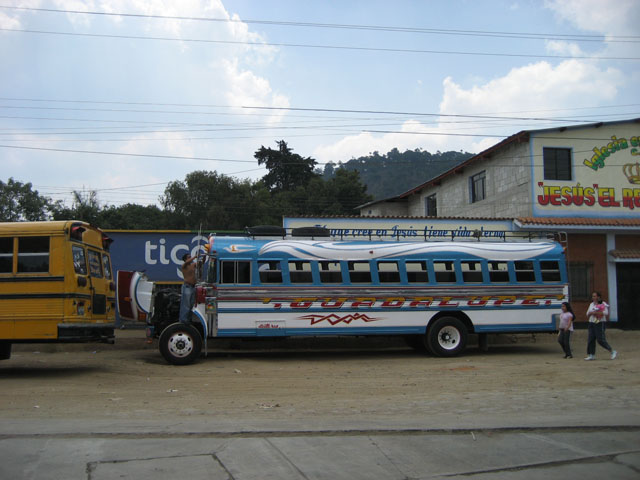
Machetes and Riding Shotgun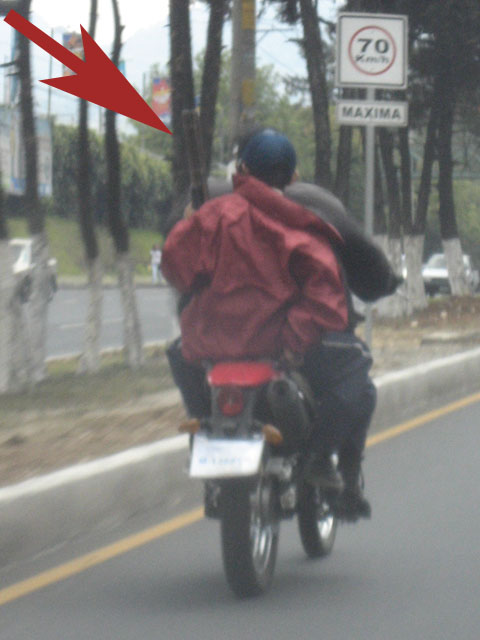
Guatemala spent about 30 years in a particularly nasty civil war that killed a great many people, and officially ended with a peace accord signed in 1996. Several tens of thousands of people (the numbers vary a bit, depending on who you ask) “disappeared”, their tortured and mutilated bodies turning up in mass graves a decade later…if ever. In some cases, entire villages were burned, the inhabitants executed, and the whole mess plowed over with bulldozers. This has had two interesting effects on the current state of affairs in Guatemala: One, there is somewhat of a vacuum of liberal/artsy/political people, as a lot of them died along with the indigenous Maya that were exterminated. Second, people don’t trust the police/army much, because they were responsible for most of the killing.
As a result, people tend to take care of themselves and there aren’t a lot of policemen doing much. Thievery and violence are pretty common here, especially in the cities, and prudent people everywhere try to be in their houses by dark, with the doors and windows barred. We all carry as little cash and valuables as possible, etc.
In the hinterlands, police availability is essentially nonexistent. Workers everywhere carry giant machetes with them as they walk to and from work- partly because it’s a handy tool for farm work, partly because it makes you a less attractive target for the thieves to pick from. Also, there is a tradition of vigilantism here… there are occasional lynchings. A volunteer we visited last week was telling us that in 2007, he had to leave his village for a week, and while he was away, someone broke into a car and stole a radio. A mob formed, dragged the fellow into the street, poured gasoline on him, and burned him to death. The volunteer decided to stay away for a few extra days, until things calmed down.
No one should worry about my (or Emily’s) safety; I am not telling this to get anyone worried. Much like going to Chicago or LA or any large American city, things here can be safe if you are smart about how you go about your business. We’ve spent a lot of time in training learning about what’s safe and what isn’t, what’s worked in the past, what the people are thinking, etc. So were a pretty well prepared. Volunteers here have a really good safety record. And if I thought Emily and I were in any sort of danger, we’d come home ASAP, because I won’t put up with it.
I added this picture of someone “riding shotgun” because it struck me as funny. Think about this the next time YOU call shotgun when you’re racing for the car. I saw this in two different places in Guatemala City on the same day; I am not sure if it’s common, or if I just got lucky. Sorry about the picture quality, i took it from a moving car, and it happened really quickly…
OK, so this is getting really long, so I am going to save two subjects for the next letter: what’s going on with the training, and the whole scoop on my host family during training. Stay tuned for further information.
(back to top)